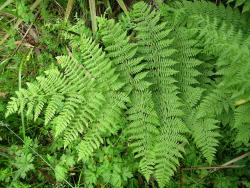Terrestrial or rupestral ferns. Rhizomes erect or creeping, scaly. Rhizome scales non-clathrate, narrowly ovate or ovate. Stipes adaxially grooved, scaly, sometimes spiny (not NZ). Laminae 2-pinnate to 3-pinnate-pinnatifid (NZ) or entire or 4-pinnate (not NZ), herbaceous (NZ) or coriaceous (not NZ), scaly, groove of rachis U-shaped and continuous with grooves of pinna midribs. Veins free or rarely anastomosing. Sori elongated along veins and either single or arranged back-to-back; indusia same shape as the sori, opening away from the vein, margins entire to laciniate. Spores monolete, perispores rugose.
A genus of about 350 species (PPG 1 2016), badly in need of monographic study (Kramer 1990) and probably paraphyletic (Wang et al. 2003). Diplazium and allied genera in Japan were more clearly defined by Kato (1977), and some 86 species were treated by Wang et al. (2013) for the Flora of China.
Allan (1961) included the sole indigenous New Zealand species in Athyrium.
| 1 | Veins anastomosing; secondary pinnae lobed less than halfway to midrib; roots producing young plants from vegetative buds | esculentum |
| Veins free; secondary pinnae usually lobed halfway or more to midrib; roots not producing young plants from vegetative buds | 2 | |
| 2 | Rhizome erect; laminae 2-pinnate-pinnatifid to 3-pinnate-pinnatifid; tertiary segments 5–38 mm long, 2–12 mm wide, serrate or divided almost to midrib, apices acute or obtuse | australe |
| Rhizome creeping; laminae 2-pinnate to 2-pinnate-pinnatifid; tertiary segments 8–11 mm long, 4–5 mm wide, entire or shallowly toothed, apices truncate or rounded | nipponicum |
In New Zealand, Diplazium can be recognised by its 2-pinnate to 3-pinnate-pinnatifid fronds bearing scales, the presence of a U-shaped groove on the adaxial surface of the rachis that is continuous with the grooves of the pinna costae, sori that are linear and arranged singly or back-to-back along the veins, and rugose spores (Large & Braggins 1991).
Worldwide, but mainly in the tropics and subtropics, with a few species extending locally into temperate regions; two species in southern Africa (Crouch et al. 2011), 86 in China (Wang et al. 2013), 10 in Australia (Jones 1998), c. 20 in the Pacific and three indigenous to Hawai‘i (Palmer 2003). One non-endemic and two naturalised species in New Zealand.
| Category | Number |
|---|---|
| Indigenous (Non-endemic) | 1 |
| Exotic: Casual | 2 |
| Total | 3 |
The base chromosome number in Diplazium is x = 40 or 41 (Kramer 1990).




